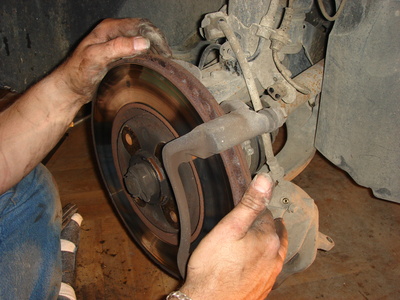
Any failure of an automobile's braking system will put the driver and others in jeopardy; it is therefore essential that the brake system be properly maintained.
Brake system reliability is substantially improved in modern disc brake systems. Maintenance of these systems is relatively simple. The brake pads and discs are consumable parts that must be changed as they wear out. The pads wear out much more quickly than the discs; it is important to know when the pads should be changed to maintain safe brake operation.
A loud metallic screeching or grinding noise when the brakes are applied is a sign that the brakes of all four wheels must be immediately inspected. Most often, the inspection will reveal a complete failure of one or more of the brake pads. At the minimum, the inside and outside brake pads on any wheel with a failed pad should be replaced.
Sometimes the braking noise is the result of contamination between the disk and the pad (rock, metal piece, etc.), in which case the problem is often solved by removing the contamination. Nicks or gouges on the brake pad could result in premature failure later.
Another source of braking noise can be the wear indicator that some manufacturers build in to their brake pads. This is usually a small metal leaf on the inside pads that will contact the disc when that pad has worn to its recommended minimum thickness.
Higher-end cars sometimes have electronic pad thickness sensors that trigger a dashboard indication that the pad needs replacement.
The brake system should be inspected at regular intervals as recommended by the automobile manufacturer. Typical recommended intervals are in the range of 12,000 to 15,000 miles. The brake pads should be visibly checked and if any grooves deeper than 1/16 inch are found, or if the pads are showing uneven wear, then the pads should be replaced.
The lining thickness should be measured. If less then the manufacturer's recommended minimum thickness at any point--typically 5/64 to 3/32 inches for passenger cars, then the pads should be replaced. Each pad should be measured at several points.
It is also important to carefully inspect pad where the lining is bonded to the heavy steel backing plate. The pads should be replaced if there is any sign of corrosion or separation in this area.
Deteriorating performance of brake performance is seldom a sign that the brake pads require replacement. Modern disk brake systems are designed to deliver consistent braking performance throughout the life of the pads and disks. Regardless, if it seems that the brakes are not performing well, then the system should be thoroughly inspected.